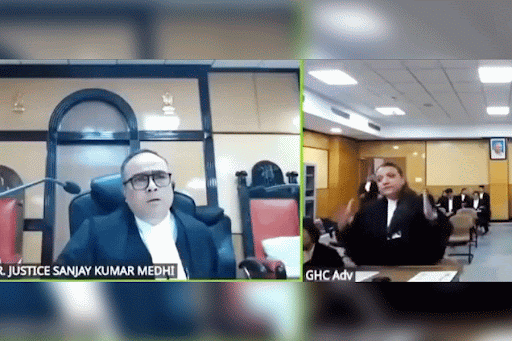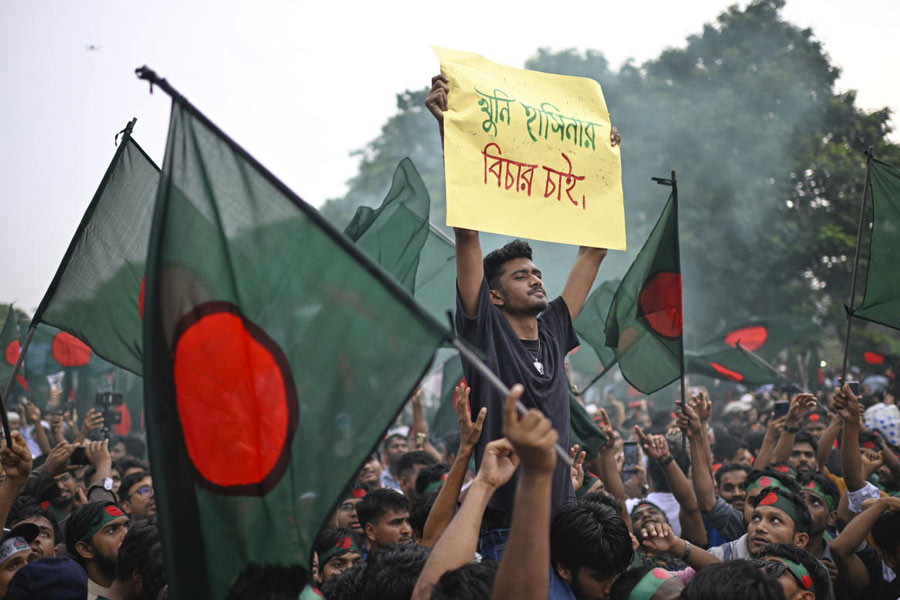 |
| Subasa Azuma speaks in Bengali as (from left) Mitsuo Kawaguchi, Shuvaprasanna, Saoli Mitra, grandmother Keiko, Bangladesh high commissioner Abida Islam and Junso Kato listen in admiration. Picture by Sayantan Ghosh |
Rabindra Okakura Bhavan which has come to occupy a pre-eminent place in the cultural map of Salt Lake over the past five years was the venue to mark the first death anniversary of the man who envisioned and funded this building housing the Indo-Japan Cultural Centre.
Kazuo Azuma, the Tagore scholar who taught for a long time in Santiniketan and spent the rest of his life spreading Tagore’s works in Japan, was remembered with deep reverence in a programme organised by Paschimbanga Bangla Akademi.
“Tagore, the world traveller, visited several countries, took the essence of their culture and history, and spread it. He was drawn to Japan just as Azuma was drawn to Tagore. This is the bond of the intellect and lasts forever,” said artist Shuvaprasanna.
Azuma’s regard for Tagore did last forever. His last wish, before his death in August 2011 was that he be “reborn as a Bengali”, said his wife Keiko, who attended the programme along with members of Tagore Association of Japan. “Ei kendrey amra ekotro hote perey khushi (We are happy to assemble in this centre),” said the frail lady, seemingly bent more with modesty than age, in a short and simple speech delivered in Bengali.
Consul-general of Japan Mitsuo Kawaguchi provided a biographical sketch of the scholar. Describing him as one of the most eminent cultural ambassadors of Japan to India, he talked of his biggest contribution — translation of Tagore’s complete works in Japanese. “Azuma sensei, as he is known to his students, took active interest in planning the building of Nippon Bhavan, which has bloomed as a major centre of excellence for study and research on Japanese language in Santiniketan. His parting gift to Bengal was this wonderful venue, the Rabindra Okakura Bhavan, which was inaugurated by our former prime minister Shinzo Abe in 2007,” he said.
Motoyoshi Noro, the former Japanese consul-general, recalled how before being posted in south-east Asia, the Japan government had appointed the Azumas to teach him Bengali. “They were soft on me as teachers. My progress was slow. And when I reached Calcutta nobody talked to me in Bengali. So I forgot everything,” he said, drawing a hearty laugh from the audience.
President of Bangla Akademi Saoli Mitra said she was excited to learn that the first Tagore play Azuma translated in Japanese was Daakghar. The play evokes a personal resonance in her as she has enacted it solo. “During World War II, the play had moved the world as a symbol of protest. Azuma too must have been affected by it,” she said.
As president of the state government’s Rabindra Rachanabali committee, she handed over the first three volumes to Keiko Azuma and Junso Kato, director of the Tagore Association in Japan.
The speech that drew the maximum applause was delivered by a nine-year-old. “Ami Kazuo Azumar naati. Ami Japan theke eshechhi. Nomoshkar,” said Subasa Azuma.
Students of the centre then sang Natmukishi hinokato — that’s Tagore’s Purano shei diner kotha in Japanese!
He speaks so softly that you have to strain your ears. The man is Japanese but the words flow in Bengali. At 76, Kazuo Azuma is back to the people and the land he has made his life. “Ami Bangla o Bangalider bhokto (I am an admirer of Bengal and Bengalis),” he says. His admiration turns into devotion when the Bengali is Rabindranath Tagore.... Soon after, the Americans carpet-bombed Tokyo. “The day was March 14. The bombing went on for three-and-a-half hours. One lakh people died and all the houses around my school were flattened to the ground for miles,” Azuma gazes vacantly at the far ceiling. Then came the aftermath. “No salt, no sugar, no food. Only TB all round. I used to bleed from the mouth.” It was at this stage that he came across a Japanese version of Daakghar retranslated from English. “I could identify with Amal, caught at home with a disease.” |











